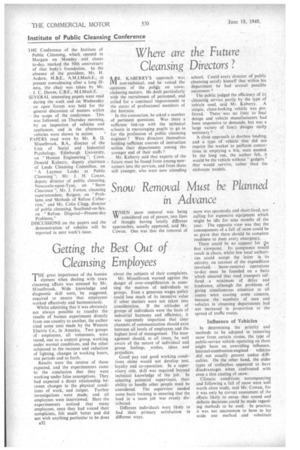Getting the Cleansing Best Out of Employees
Page 34

Page 35

If you've noticed an error in this article please click here to report it so we can fix it.
THE great importance of the human element when dealing with town cleansing affairs was stressed by Mr.
isselb rook . Wide knowledge and diagnostic skill were, he suggested, required to ensure that employees worked effectively and harmoniously.
Whilst admitting that it was obviously not always possible to transfer the results of human experiments directly from one country to another, the author cited some tests made by the Western Electric Co., in America. Two groups of employees, all volunteers, were tested, one as a control group, working under normal conditions, and the other subjected to theincrease and reduction of lighting, changes in working hours, rest periods and so forth.
Results were the reverse of those expected, and the experimenters came to the conclusion that they were working under false assumptions. They had expected a direct relationship between changes in the physical conditions of work, and output. Further investigations were made, and all employees were interviewed. Here the experimenters noticed that many employees, once they had voiced their complaints, felt much' better and did not wish anything particular to be done A32 about the subjects of their complaints.
Mr. Misselbrook warned against the danger of over-simplification in assessing the motives of individuals or groups, Even a generous wages policy could lose much of its incentive value if other matters were not taken into consideration. If the attitudes of groups of individuals were the basis of industrial harmony and efficiency, it was supremely important that clear channels of communication should exist between all levels of employees and the highest level of management. The management should, at all times, be well aware of the nature' of individual and group feelings, _wishes, ideas and prejudices.
Good pay and good working conditions alone would not develop zest, loyalty and co-operation. In a supervisory role, skill was required beyond technical knowledge of the job. in selecting potential supervisors, their ability to handle other people mast be considered. The supervisor needed some basic training in ensuring that the load in a team job was evenly distributed.
Different individuals were likely to find their primary satisfaction in different ways. snow was spasmodic and short-lived, not calling for expensive equipment which might be idle for nine months of the year. The opposite view was that the consequences of a fall of snow could be so grave that there should be complete readiness to meet every emergency.
There could be no support for Tolle first , viewpoint. Its acceptance would result in chaos, whilst few local authorities could accept the latter in its entirety, on account of the expenditure involved. Snow-removal operations to-day must be founded on a basis which ensured that road transport suffered a minimum of delay and hindrance, although the problems of giving simultaneous attention to all routes were causing some concern, because the numbers of men and -vehicles in cleansing departments had not increased in proportion to the spread of traffic routes.
Influence of Vehicles
In determining the priority and methods to be adopted in removing snow from certain routes, the type of public-service vehicle operating on them might have an overriding influence. Internal-combustion-engined vehicles did not usually present undue difficulties. On the other hand, the older types of trolleybus appeared to have disadvantages when confronted with even a thin coating of snow.
Climatic conditions accompanying and following a fall of snow were well worth close study, said Mr. Cowan, for it was only by correct assessment of the effects likely to ensue that sound and definite decisions could be made regarding methods to be used. In practice, it was not uncommon to have to lay aside one method and substitute
another, because of a slight rise or fall in temperature. Changes in temperature could continue with disconcerting frequency in the short period of 15 minutes.
The issue of weather forecasts by the Air Ministry to local authorities had been of value, as they gave officials the all-important factor of time in which to start operations based upon a preconceived plan. They did not, however, give time in which to prepare a plan— a plan which should have been completed long before the onset of winter.
Snow ploughs were, in the main, of V-blade, or straight-blade design, continued Mr. Cowan. In most instances the motive power to propel them was supplied by vehicles in everyday use by local authorities. Channel ploughs were of inestimable value in opening up channels at the time of thaw.
Improvisation Paid In the snowfall of 1947, wide use was made of civil-engineering mobile plant, not designed primarily for snow removal, Bulldozers, angledozers and similar machines were of great value in clearing tracks through deep, uncompacted snow. Mechanical loading was, at present, more or less confined to mechanical shovels, unwieldy on busy town roads and more suited to night operations.
In the removal of snow by thawing, a mixture of one part salt to two parts inert material was required if the work was to be effective. The rate at which the mixture was applied could be
properly controlled only if mechanical gritting machines were used. Under conditions which allowed the complete disposal of snow and ice by salt mixtures, economic advantages obviously accrued, for costly methods of transport were avoided.
If ploughing were to be effective, it must remain in constant operation until climatic conditions made its further use unnecessary. In nearly all cases, snow ploughs needed to be operated in pairs, to ensure an accommodating width for vehicles.




















































































